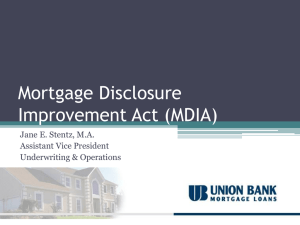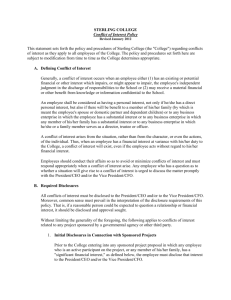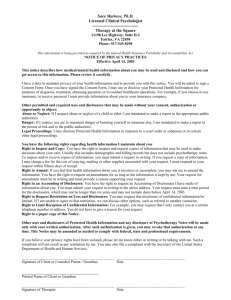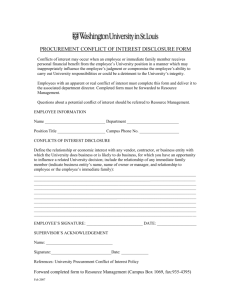Statutory Accounting Principles Working Group
advertisement
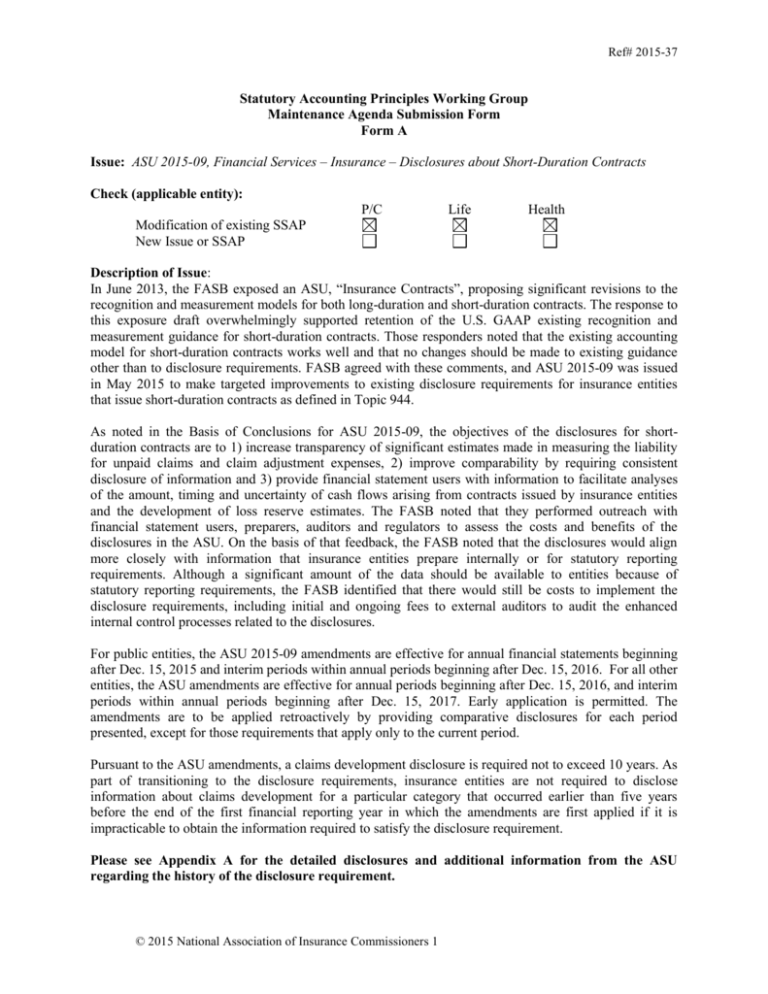
Ref# 2015-37 Statutory Accounting Principles Working Group Maintenance Agenda Submission Form Form A Issue: ASU 2015-09, Financial Services – Insurance – Disclosures about Short-Duration Contracts Check (applicable entity): P/C Life Health Modification of existing SSAP New Issue or SSAP Description of Issue: In June 2013, the FASB exposed an ASU, “Insurance Contracts”, proposing significant revisions to the recognition and measurement models for both long-duration and short-duration contracts. The response to this exposure draft overwhelmingly supported retention of the U.S. GAAP existing recognition and measurement guidance for short-duration contracts. Those responders noted that the existing accounting model for short-duration contracts works well and that no changes should be made to existing guidance other than to disclosure requirements. FASB agreed with these comments, and ASU 2015-09 was issued in May 2015 to make targeted improvements to existing disclosure requirements for insurance entities that issue short-duration contracts as defined in Topic 944. As noted in the Basis of Conclusions for ASU 2015-09, the objectives of the disclosures for shortduration contracts are to 1) increase transparency of significant estimates made in measuring the liability for unpaid claims and claim adjustment expenses, 2) improve comparability by requiring consistent disclosure of information and 3) provide financial statement users with information to facilitate analyses of the amount, timing and uncertainty of cash flows arising from contracts issued by insurance entities and the development of loss reserve estimates. The FASB noted that they performed outreach with financial statement users, preparers, auditors and regulators to assess the costs and benefits of the disclosures in the ASU. On the basis of that feedback, the FASB noted that the disclosures would align more closely with information that insurance entities prepare internally or for statutory reporting requirements. Although a significant amount of the data should be available to entities because of statutory reporting requirements, the FASB identified that there would still be costs to implement the disclosure requirements, including initial and ongoing fees to external auditors to audit the enhanced internal control processes related to the disclosures. For public entities, the ASU 2015-09 amendments are effective for annual financial statements beginning after Dec. 15, 2015 and interim periods within annual periods beginning after Dec. 15, 2016. For all other entities, the ASU amendments are effective for annual periods beginning after Dec. 15, 2016, and interim periods within annual periods beginning after Dec. 15, 2017. Early application is permitted. The amendments are to be applied retroactively by providing comparative disclosures for each period presented, except for those requirements that apply only to the current period. Pursuant to the ASU amendments, a claims development disclosure is required not to exceed 10 years. As part of transitioning to the disclosure requirements, insurance entities are not required to disclose information about claims development for a particular category that occurred earlier than five years before the end of the first financial reporting year in which the amendments are first applied if it is impracticable to obtain the information required to satisfy the disclosure requirement. Please see Appendix A for the detailed disclosures and additional information from the ASU regarding the history of the disclosure requirement. © 2015 National Association of Insurance Commissioners 1 Ref# 2015-37 Comparison to IFRS: IFRS 4, Insurance Contracts, addresses the financial reporting for insurance contracts by any entity that issues insurance contracts (as defined IFRS 4). IFRS 4 will require an insurer to disclose information that identifies and explains the amount in its financial statements arising from insurance contracts similar to existing disclosure requirements in FASB Codification Topic 944. (A key difference from IFRS 4 is that Topic 944 only applies to short-duration contracts.) In addition to IFRS 4, the IASB had a 2013 exposure draft “Insurance Contracts” proposing new recognition, measurement, presentation and disclosure guidance. A comparison between the ASU disclosures and the IFRS 4 and 2013 Exposure Draft disclosures are in ASU 2015-09, but the following lists key elements / differences of the standards: Amendments in ASU 2015-09 do not require disclosures about the sensitivity to insurance risk and concentrations of insurance risk. However, the amendments do require insurance entities to disclose information similar to IFRS 4 about claims development, albeit a lower level of aggregation than IFRS 4. Amendments in ASU 2015-09 only apply to insurance entities that issue short-duration contracts and only amend disclosure requirements. As a result, the recognition, measurement, and presentation guidance for short-duration contracts under GAAP will differ from the guidance under IFRS when the FASB finalizes the guidance. The 2013 IFRS Exposure Draft guidance would require an entity to disclose reconciliations of insurance contract assets and liabilities. The amendments in the ASU require insurance entities to similarly disclose in interim and annual financial statements a rollforward of the liability for unpaid claims and claims adjustment expenses. The 2013 IFRS Exposure Draft guidance would require an entity to disclose actual claims compared with previous estimates of the undiscounted amount of the claims. The disclosure would go back to the period in which the earliest material claims arose for which there was uncertainty about the amount and timing of the claim payments, not to exceed 10 years. Also, under the IFRS proposal, entities would not need to disclose info about claims development for claim payments typically resolved within one year. For the ASU, the disclosures have a similar paid claims development not to exceed 10 years, but periods that precede the most recent reporting period are considered supplementary information. Also, there is no exemption for information about the development of claims for which uncertainty about the amount and timing of the claims payments is typically resolved within one year. The 2013 IFRS Exposure Draft guidance and the ASU amendments both provide a disaggregation principle that states that an entity should aggregate or disaggregate information so that useful information is not obscured by either the inclusion of a large amount of insignificant detail or by the aggregation of items that have different characteristics. Both versions are expected to provide examples of disaggregation categories that include major product line, geography or reportable segment. The 2013 IFRS Exposure Draft guidance would require additional disclosures that are not required by the ASU amendments – such as qualitative and quantitative information about the nature and extent of risks arising from insurance contracts, including a sensitivity analysis that shows any material effect on profit on loss and equity. © 2015 National Association of Insurance Commissioners 2 Ref# 2015-37 The ASU amendments require disclosures that are not anticipated with the 2013 IFRS Exposure Draft guidance – such as history of claims duration, incurred-but-not-reported liabilities plus expected development on reported claims, and information about claim frequency. (As the IFRS guidance is not yet final, additional disclosures may be proposed to make the final IASB disclosures more converged or less converged with the ASU.) Existing Authoritative Literature: SSAP No. 55—Unpaid Claims, Losses and Loss Adjustment Expenses: Disclosures: 16. 17. The financial statements shall include the following disclosures for each year full financial statements are presented. The disclosure requirement in paragraph 16.d. is also applicable to the interim financial statements if there is a material change from the amounts reported in the annual filing. Life and annuity contracts are not subject to this disclosure requirement. a. The balance in the liabilities for unpaid claims and unpaid losses and loss/claim adjustment expense reserves at the beginning and end of each year presented; b. Incurred claims, losses, and loss/claim adjustment expenses with separate disclosures of the provision for insured or covered events of the current year and increases or decreases in the provision for insured or covered events of prior years; c. Payments of claims, losses, and loss/claim adjustment expenses with separate disclosures of payments of losses and loss/claim adjustment expenses attributable to insured or covered events of the current year and insured or covered events of prior years; d. The reasons for the change in the provision for incurred claims, losses, and loss/claim adjustment expenses attributable to insured or covered events of prior years. The disclosure should indicate whether additional premiums or return premiums have been accrued as a result of the prior-year effects; e. A summary of management's policies and methodologies for estimating the liabilities for losses and loss/claim adjustment expenses, including discussion of claims for toxic waste cleanup, asbestos-related illnesses, or other environmental remediation exposures; f. Disclosure of the amount paid and reserved for losses and loss/claim adjustment expenses for asbestos and/or environmental claims, on a direct, assumed and net of reinsurance basis (the reserves required to be disclosed in this section shall exclude amounts relating to policies specifically written to cover asbestos and environmental exposures). Each company should report only its share of a group amount (after applying its respective pooling percentage) if the company is a member of an intercompany pooling agreement; and g. Estimates of anticipated salvage and subrogation (including amounts recoverable from second injury funds, other governmental agencies, or quasi-governmental agencies, where applicable), deducted from the liability for unpaid claims or losses. All reporting entity types are required to disclose the dollar amount of any claims/losses related to extra contractual obligation lawsuits or bad faith lawsuits paid during the reporting period on a direct basis. The number of such claims paid shall be disclosed in a note. © 2015 National Association of Insurance Commissioners 3 Ref# 2015-37 18. Refer to the preamble for further discussion regarding disclosure requirements. SSAP No. 65—Property and Casualty Contracts 10. With the exception of fixed and reasonably determinable payments such as those emanating from workers' compensation tabular indemnity reserves and long-term disability claims, property and casualty loss reserves shall not be discounted. No loss adjustment expense reserves shall be discounted. 11. Tabular reserves are indemnity reserves that are calculated using discounts determined with reference to actuarial tables which incorporate interest and contingencies such as mortality, remarriage, inflation, or recovery from disability applied to a reasonably determinable payment stream. Tabular reserves shall not include medical loss reserves or loss adjustment expense reserves. 12. Due to several instances in which states have prescribed or permitted practices to allow discounting on a non-tabular basis, recommended guidelines for discounting non-tabular unpaid loss and LAE are provided within Exhibit A. If a state has a prescribed or permitted practice allowing the use of discounts, or if discounting is utilized in accordance with this SSAP, financial statement disclosures are required in accordance with paragraphs 13-16. 13. In accordance with SSAP No. 3—Accounting Changes and Corrections of Errors (SSAP No. 3), a change in the discount rate used in discounting loss reserves shall be accounted for as a change in estimate. SSAP No. 3 requires changes in estimates to be included in the statement of income in the period the change becomes known. 14. The financial statements shall disclose whether or not any of the liabilities for unpaid losses or unpaid loss adjustment expenses are discounted, including liabilities for workers' compensation. The following disclosures, for each line of business, shall be made separately: a. Table(s) used; b. Rate(s) used; c. The amount of discounted liability reported in the financial statement; and d. The amount of tabular discount, by the line of business and reserve category (i.e., case and Incurred But Not Reported (IBNR)). 15. If the rate(s) used to discount prior accident years' liabilities have changed from the previous financial statement or if there have been changes in other key discount assumptions such as payout patterns, the financial statements shall disclose: 16. a. Amount of discounted current liabilities at current rate(s) and assumption(s) (exclude the current accident year); b. Amount of discounted current liabilities at previous rate(s) and assumption(s) (exclude the current accident year); c. Change in discounted liability due to change in interest rate(s) and assumption(s); and d. Amount of non-tabular discount, by line of business and reserve category (i.e., case, defense and cost containment, adjusting and other). Refer to the preamble for further discussion regarding disclosure requirements. Schedule P – Schedule P intends to display a summary containing ten years of historical data for all lines of business. There are 7 parts and interrogatories within Schedule P: Part 1 – Detailed info on losses and loss expenses Part 2 – History of incurred losses and defense and cost containment expenses Part 3 – History of loss and defense and cost containment payments © 2015 National Association of Insurance Commissioners 4 Ref# 2015-37 Part 4 – History of bulk and incurred but not reported (IBNR) reserves. Part 5 – History of claims Part 6 – History of premiums earned Part 7 – History of loss sensitive contracts Interrogatories – Provides for additional calculation and explanation of various amounts. A discount implicit in tabular reserves may be included in Part 1. Part 2 is to be reported gross of all discounts. Otherwise, Schedule P is to be presented on a non-discounted basis. The reserves reported are expected to represent the ultimate amounts to be paid, including anticipated inflation. If discounting of loss or loss expense reserves is reflected on any line on Page 3 of the Annual Statement, reconciliation is provided in Part 1. Workpapers related to any discount amounts must be available for examination upon request, but the tabular reserve discount does not need to be shown separately. Activity to Date (issues previously addressed by SAPWG, Emerging Accounting Issues WG, SEC, FASB, other State Departments of Insurance or other NAIC groups): The Statutory Accounting Principles (E) Working Group provided comment in response to the 2013 FASB Insurance Contracts Exposure Draft. This letter included the following statement: As one significant improvement, U.S. regulators strongly support the proposed inclusion of undiscounted claims development, as it is critical information allowing users to understand the insurer’s ability to properly underwrite and anticipate claims. With this new disclosure, which can be completed by insurers without cost or complexity as it is already required under statutory accounting principles, users of U.S. GAAP financials will be able to readily obtain this key performance information. Information or issues (included in Description of Issue) not previously contemplated by the SAPWG: None Staff Recommendation: Staff recommends that the Working Group move this agenda item to the nonsubstantive active listing and expose this agenda item, with a request for comments from regulators and industry reps on the GAAP disclosures for short-duration insurance contracts and whether revisions to statutory accounting disclosures should be considered in response to the ASU 2015-09 requirements. (Note – A brief presentation is expected during the Summer National Meeting, as time allows, from interested parties on this ASU.) Staff Review Completed by: Julie Gann – July 2015 Status: On August 15, 2015, the Statutory Accounting Principles (E) Working Group moved this item to the nonsubstantive active listing and exposed this agenda item with a request for comments on the GAAP disclosures for short-duration insurance contracts and whether revisions to statutory accounting disclosures should be considered. G:\DATA\Stat Acctg\3. National Meetings\A. National Meeting Materials\2015\Summer\NM Exposures\15-37 - ASU 2015-09 - Insurance Disclosures.docx © 2015 National Association of Insurance Commissioners 5 Ref# 2015-37 Detail of ASU 2015-09 Disclosure Revisions & FASB Basis of Conclusions: Short-Duration Contracts > Information about the Liability for Unpaid Claims and Claim Adjustment Expenses (New Guidance) 944-40-50-4A For health insurance claims, an insurance entity shall aggregate or disaggregate the information in paragraph 944-40-50-3 so that useful information is not obscured by either the inclusion of a large amount of insignificant detail or the aggregation of items that have significantly different characteristics (see paragraphs 944-40-55-9A through 55-9C). 944-40-50-4B For annual reporting periods, an insurance entity shall disclose in a tabular format, as of the date of the latest statement of financial position presented, undiscounted information about claims development by accident year, including separate information about both of the following on a net basis after risk mitigation through reinsurance: a. Incurred claims and allocated claim adjustment expenses b. Paid claims and allocated claim adjustment expenses. The disclosure about claims development by accident year should present information for the number of years for which claims incurred typically remain outstanding, but need not exceed 10 years including the most recent reporting period presented. All periods presented in the disclosure about claims development that precede the most recent reporting period shall be considered supplementary information. For the most recent reporting period presented, the disclosure about claims development shall include the total net outstanding claims for accident years not separately presented as part of the claims development (see paragraph 944-40-55-9E). 944-40-50-4C For annual reporting periods, an insurance entity shall reconcile the disclosure about incurred and paid claims development information to the aggregate carrying amount of the liability for unpaid claims and claim adjustment expenses for the most recent reporting period presented, with separate disclosure of reinsurance recoverable on unpaid claims (see paragraph 944-40-55-9E). ASU Discussion – Incurred and Paid Claims Development Tables: Many preparers representing property/casualty insurance entities supported disclosures of claims development tables to provide financial statement users with information to better understand an insurance entity’s ability to underwrite and anticipate costs associated with claims. Many commented that these disclosures would increase the transparency of the liability for unpaid claims and claim adjustment expenses by facilitating an analysis of initial liability estimates and subsequent adjustments to those estimates. Financial statement users noted that information about the liability for unpaid claims and claim adjustment expenses is available from statutory filings and Form 10-K, but that the usefulness of the information is limited: 1. Statutory Schedule P includes 10 years of claims development by line of business, but claims development is provided for each legal entity separately and is required only for entities domiciled in the United States. For domestic entities, significant effort is required to aggregate data across various legal entities for each line of business and to reconcile the information to an insurance entity’s GAAP financial statements, whereas for multinational entities, aggregate statutory information cannot be reconciled to GAAP financial statements. 2. The loss reserve development table required by the SEC’s Security Act Industry Guide present information for the consolidated entity for 10 calendar years. Disaggregated information by accident year and policy characteristics would be more useful in understanding how reserve estimates change in relation to payment history for different policy characteristics. As a result of this feedback, the FASB decided to require disclosure of incurred and paid claims development tables that include information for the number of years for which claims incurred typically © 2015 National Association of Insurance Commissioners 6 Ref# 2015-37 remain outstanding, but for which the disclosure need not exceed 10 years, including the most recent reporting period presented. All claims development years should be presented together, and the most useful way to present is by accident year and disaggregated. The Board noted that requiring 10 years of information can have repercussions on auditor independence, and could add significant costs and complexities to auditor independence assessments of predecessor and successor auditors. As such, the Board decided that all years presented that precede the most recent reporting period should be considered supplementary information. This supplementary information may be presented as a supplementary schedule outside the audited notes or which the financial statement notes accompanied by a clear distinction to other disclosed information. The Board noted that entities are not precluded from having the entire claims development table audited. > Information about Claim Frequency and Severity (New Guidance) 944-40-50-4D For annual reporting periods, an insurance entity shall quantitatively disclose the following for each accident year presented in the disclosures about incurred claims development (see paragraph 944-4055-9E) for the most recent reporting period presented: a. The total of incurred-but-not-reported liabilities plus expected development on reported claims included in the liability for unpaid claims and claim adjustment expenses b. Cumulative claim frequency information, unless it is impracticable to do so. If it is impracticable to disclose claim frequency information, where the term impracticable has the same meaning as impracticability in paragraph 250-10-45-9, an insurance entity shall disclose that fact and explain why the disclosure is impracticable. 944-40-50-4E For interim and annual reporting periods, for health insurance claims, an insurance entity shall disclose the total of incurred-but-not-reported liabilities plus expected development on reported claims included in the liability for unpaid claims and claim adjustment expenses. 944-40-50-4F An insurance entity shall describe both of the following: a. Its methodologies for: 1. Determining the presented amounts of both incurred-but-not reported liabilities and expected development on reported claims required by paragraphs 944-40-50-4D through 50-4E 2. Calculating cumulative claim frequency information required by paragraph 944-40-50-4D b. Significant changes to those methodologies. When describing (2) above the insurance entity also shall include whether frequency is measured by claim event or individual claimant and how the insurance entity considers claims that do not result in a liability (see paragraph 944-40-55-9D). ASU Discussion – Frequency and Severity: Financial statement users commented that understanding claims frequency and severity is very important for understanding property/casualty insurance entities and that additional disclosures would increase transparency of an insurance entity’s estimation practices and claims experience. Financial statement users currently have access to claims frequency information included in statutory Schedule P filings, but because this information is only available on a legal entity basis for entities domiciled in the US, significant effort is required to compile and aggregate information. The Board decided to require disclosure of cumulative claims frequency information for each accident year presented in the disclosures unless it is impracticable to do so. (This impracticability exception addresses situations in which frequency info is not available, such as assumed reinsurance or residual market pools.) To enable users to interpret the frequency info properly, the Board decided that insurance entities should disclose its methodologies for calculating cumulative claim frequency info as well as any significant changes to those methodologies. These disclosures are intended to allow users to understand how an © 2015 National Association of Insurance Commissioners 7 Ref# 2015-37 insurance entity calculated frequency (e.g., measured by claim event or be individual claimant) and how an insurer considered claims that did not result in a liability. To allow the calculation of average severity of reported claims (without liabilities for claims incurred but not reported), the FASB decided to require insurance entities to present in the incurred claims development tables separate information about the total of incurred-but-not-reported liabilities, plus expected development on reported claims included in the liability for unpaid claims and claim adjustment expenses. The Board agreed to include expected development on reported claims in the disclosure of the total incurred-but-not-reported liabilities to avoid introducing a new metric. The FASB identified that this decision will align the incurred-but-not-reported definitions in GAAP and statutory reporting. To address concerns on different methodologies used by insurance entities, the Board decided that insurance entities should disclose its methodologies for determining the presented amounts. > History of Claims Duration (New Guidance) 944-40-50-4G For annual reporting periods, for all claims except health insurance claims, an insurance entity shall disclose as supplementary information the historical average annual percentage payout of incurred claims by age, net of reinsurance (that is, history of claims duration by age), as of the most recent reporting period. This information shall be disclosed for the same number of accident years presented in the disclosures required by paragraph 944-40-50-4B (see paragraphs 944-40-55-9F through 55-9G). ASU Discussion – History of Claims Duration & Health Insurer Exception: The Board decided that an insurance entity should disclose the average annual percentage payout of claims in order to provide users with info that can be used in independent discounting analyses and to provide insight into claim settlement practices. Because these calculations are based on supplemental information included in the claims development tables, the FASB noted that the resulting history of claims duration is also considered supplemental information. Although some commenters supported the exclusion of health insurance claims from the incurred and paid claims development, the FASB decided not to exclude them as some health insurance claims extend beyond one year and users have indicated that information about changes in estimates of the liability are decision useful. (The Board expects that the disclosure of claims development for health insurers will typically include less than 10 years of information.) The Board did agree that health insurance claims should be excluded from the annual disclosure of the history of claims duration because of the very short duration of those claims and because users focus on claims development in interim periods as well as annually. Instead, the Board decided that the rollforward of the liability for unpaid claims and claim adjustment expenses for health insurance claims should be disaggregated and that the total of incurredbut-not-reported liabilities plus expected development on reported claims for health insurance claims should be disclosed in both interim and annual financial statements, either as a separate disclosure or as a component of the rollforward of the liability for unpaid claims and claim adjustment expenses. > Presentation and Aggregation of Disclosures (New Guidance) 944-40-50-4H An insurance entity shall disclose the information required by paragraphs 944-40-50-4B through 50-4G and 944-40-50-5 in a manner that allows users to understand the amount, timing, and uncertainty of cash flows arising from the liabilities. An insurance entity shall aggregate or disaggregate the disclosures in paragraphs 944-40-50-4B through 50-4G and 944-40-50-5 so that useful information is not obscured by either the inclusion of a large amount of insignificant detail or the aggregation of items that have significantly different characteristics (see paragraphs 944-40-55-9A through 55-9C). An insurance entity need not provide disclosures about claims development for insignificant categories; however, balances for insignificant categories shall be included in the reconciliation required by paragraph 944-40-50-4C. 944-40-50-4I For annual reporting periods, an insurance entity shall disclose information about significant changes in methodologies and assumptions used in calculating the liability for unpaid claims and claim © 2015 National Association of Insurance Commissioners 8 Ref# 2015-37 adjustment expenses, including reasons for the change and the effects on the financial statements for the most recent reporting period presented. ASU Discussion – Presentation and Disaggregation of Disclosures: Financial statement users commented that understanding the effects of differences between components on the liability for unpaid claims and claim adjustment expenses was important to their analyses. As such, the Board decided that the disclosures should be communicated in a manner that allows users to understand the amount, timing, and uncertainty of cash flows arising from its contracts in light of relevant circumstances. This decision also requires insurance entities to disaggregate or aggregate disclosures so that useful information is not obscured by the inclusion of a large amount of insignificant detail or the aggregation of items that have significantly different characteristics. As useful disaggregate depends on the characteristics of contracts that an entity writes and on various entity-specific factors, the Board did not prescribe any specific factor to be used as the basis for disaggregating disclosures. Due to concerns on possible voluminous disclosures, the Board provided implementation guidance about how to determine appropriate categories. > > Information about Amounts Reported at Present Value (Revised Existing Disclosures) 944-40-50-5 For liabilities for unpaid claims and claim adjustment expenses that are presented at present value in the financial statements, an insurance entity insurance entities shall disclose both all of the following in its annual financial statements: a. For each period presented in the statement of financial position, the carrying amount of liabilities for unpaid claims and claim adjustment expenses relating to short-duration contracts that are presented at present value b. The range of interest rates used to discount the liabilities disclosed in (a). c. The aggregate amount of discount related to the time value of money deducted to derive the liabilities disclosed in (a) d. For each period presented in the statement of income, the amount of interest accretion recognized e. The line item(s) in the statement of income in which the interest accretion is classified. ASU Discussion – Present Value: Topic 944 required an insurance entity to disclose the carrying amount of claims liabilities that are presented at present value in the financial statements and the range of interest rates used to discount those liabilities (paragraphs a-b above). However, it was noted that there was no requirement to disclose the discount deducted from the liability for unpaid claims and claim adjustment expenses and the effects of interest accretion on the statement of income. To provide better info, the FASB decided that for each period presented, the insurance entity should disclose the aggregate amount of discount relating to the time value of money deducted from the liability for unpaid claims and claim adjustment expenses, the amount of interest accretion recognized, and the line items in the statement of comprehensive income in which the interest accretion is recognized. The Board considered whether to require entities to disclose the rates that would be used to discount liabilities that are not presented at present value to provide users with management’s view about the risks inherent in the liabilities and a starting point to perform independent discounting analyses. The Board rejected this proposed disclosure. © 2015 National Association of Insurance Commissioners 9
